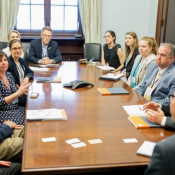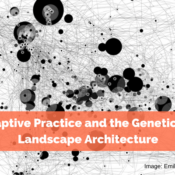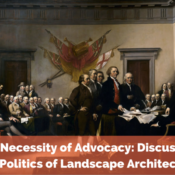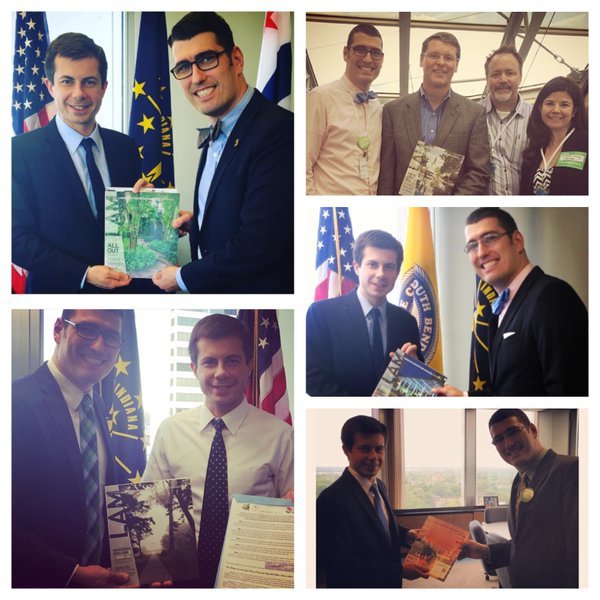Author: Jonathon Geels
5 Trends Shaping Landscape Architecture in 2018
By its nature, design evolves, responding to both context and conscious. Reflecting on the prestige and tumult of 2017 (there’s too many to list), has me wondering what the next iteration of landscape architecture will be. What’s on the horizon? What are the groundswell moments that will continue to gain momentum, and what are the emerging challenges that we must confront? From the continued ripples of the LAF Declaration to finding legislative footholds to the powerful Black in Design conference, 2017 was the year that landscape architects awoke to find value in participation beyond practice as well as placing continued emphasis on of the role of place in justice, economics, and environmental stability. In no particular order, here are 5 topics that are permeating the profession of landscape architecture right now.

Design practice has never fit into a box and is employing community engagement strategies with increasing success.
Hybrid Practice
Hybrid practice, alt-practice, adapting practice – no matter the term, the accumulative value of non-traditional design methodologies is a topic gaining increasing traction for landscape architects. In a recent Land8 article, I wrote:
“As society responds to inconstancy in economic, social, and environmental change, the necessity for ‘good design’ continues to adapt and become more prevalent, it is essential to engage in a new process of design, for both personal and professional gain. Tactical Urbanism and its myriad of low cost, temporary design approaches and its contemporaries (Project For Public Spaces and lighter, quicker, cheaper), spurred a different way of thinking about design. It is a subtle difference between human-centric, capacity building approaches and the more common problem-solving based processes, but far more participatory and responsive to end users. Increasingly, these non-traditional techniques are finding a foothold in design, but what role do designers have in rogue design? Already, as financial constraints for clients and communities have tightened, landscape architects have had to find a way to sustain their organizations. Small practitioners in particular have had to be nimble, identifying unique and profitable markets separate from developing drawings.”
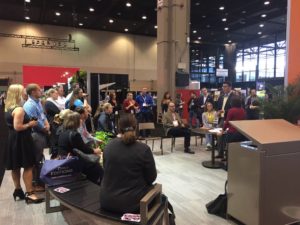
Hybrid practice themed presentations at the ASLA Annual Meeting are becoming more and more common.
While the role of traditional landscape architecture continues to adapt and evolve, what remains clear is the increasing value of cross-disciplinary collaboration, understanding the transferable skills of the profession, and developing new methods to practice.
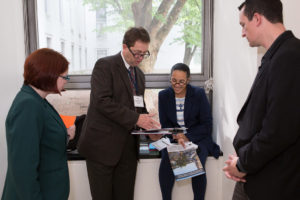
INASLA representatives discuss the legislative priorities of landscape architects with policymakers.
Advocacy and Activism
Prioritizing advocacy and activism within practice has very real economic implications. These include everything from marketplace perception (how genuine are your convictions and how does that prove what you’re good at) to leveraging potential tax credits (volunteer hours and in kind donations) to the legitimate funding of the product of landscape architecture and the impact of regulation on places and small businesses. Government affairs initiatives can lead to substantial economic gain and strengthen the impact of landscape architects. McKinsey and Company notes, “The business value at stake from government and regulatory intervention is huge: about 30 percent of earnings for companies in most industries.” That figures roughly $630M in potential impact to landscape architecture design services nationally, using figures from a 2015 NEA Report.
Landscape architects have had a hell of a year confronting nonstop deregulation battles to continual challenges to the funding that keeps landscape architects employed. According to ASLA’s Government Affairs team, from 2010 to 2015 there were 26 challenges to landscape architecture licensure. In 2017, there were over twenty, in some form or another. Unfortunately, this trend looks to continue threatening an uncertain financial foothold. Only further activism and advocacy will strengthen the position of the profession.
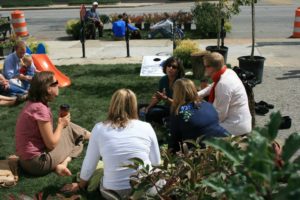
Parks are community infrastructure too.
Community Infrastructure
Infrastructure is the most bipartisan issue in the United States right now. It’s hard to disagree with bridges and roads literally crumbling underneath us. Decades of deferred maintenance have come home to roost and only substantial investment will mitigate what could be catastrophic impact to industry and the public. State DOTs still shape many municipal standards, from which design software is preferable to whether or not to add fiber mesh to sidewalks.
As this reinvestment runs the bureaucratic gamut, landscape architects have the opportunity to inject themselves into the conversation, leading to better ways to design this infrastructure and the systems that infrastructure impacts (stormwater management, ecologic systems, public health, etc.). The rise of groups like NACTO will only strengthen the role of landscape architects in this dialogue, espousing design standards landscape architects have long advocated, such as pedestrian-oriented design.
With the dawn of new technology that will reshape society’s experience of infrastructure, such as the way that self driving cars will begin to shape roadways, municipalities cannot employ the same engineering standards. With advocacy and demonstrated alternative tactics, landscape architects can contribute to a remaking of community infrastructure with once in a generation opportunities to improve the way our cities work. Think integration, not sprawl. The anti-Apple campus.
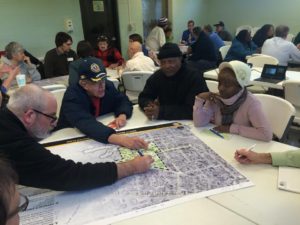
South Bend residents discuss land use options for adjacent open space at public planning meeting.
Community Driven Design
All of the marches and protests of late 2016 and throughout 2017 lead to a deeper expectation of all of our public spaces. As Fast Company recently pointed out, the implications of boutique urbanism are appropriately being reevaluated. This shift toward community-centric design isn’t new; design firms like IDEO and Greater Good Studio have long championed the process of placing users at the forefront. At the same time, small landscape architecture firms have lived off of 5-year Master Plans for Parks Departments over the last few years, all with required community feedback components. This time, though, landscape architects have the opportunity to stress their expertise in public engagement and let that drive the direction of public space design rather than simply checking boxes and supplying a catalogue of unheeded feedback. Designing with, not for.
Geared toward supporting capacity rather than simply projecting solutions to problems, empathetic design hopefully ushers in an era of more equitable public spaces.

The tools landscape architects have long used will be important in how we address climate change.
Climate Responsive Design
From wildfires to hurricanes, 2017 was a devastating year regarding climate-related natural disasters. Whether or not you think climate change is a result of human industry, design responses to those disasters will be decidedly human led. Simply adding more and more funds to FEMA is unsustainable. The engineered strategies of the last five decades have created as many problems as they have solved, signalling an important rise in solutions that landscape architects have long espoused. Whether or not the profession can capitalize on our marketplace positioning remains to be seen. Comparably minuscule numbers undermine that opportunity, a fact both lamented and bolstered in the LAF Declaration book.
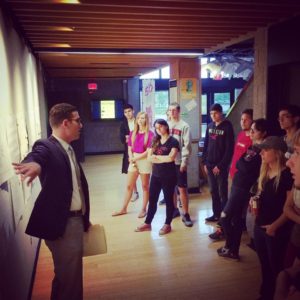
From juries to advisory boards, find a way to get involved and join the fray.
5 Things To Start Doing Right Now:
- Practice grit advocacy: the day-to-day hustle; don’t settle for the base level design standards and challenge the status quo.
- Practice empathetic design. Much of the process of landscape architecture deals with the human impact on the environment. Embrace the embodied ethics of the profession. Stewardship is a conviction, not a trend. Meaning, show don’t tell.
- Design like you give a damn. The billable hours and productivity driven mindset places limitations on the already undervalued design process. Show some initiative and work beyond those limitations, if not for your clients, for yourself.
- Future proof the profession: Describe your practice and yourself in terms of transferable skills, especially as new fields, collaboration opportunities, and areas of practice emerge.
- Facilitate the intersection of theory and practice. Find out what the kids are talking about. Research, read, and get involved. Even if you don’t have a design school nearby, sit on an awards jury (which are often teleconferences) or just call your alma mater and see what’s new. Innovation is born at the intersection of theory and real life practice.
Lead Image: SB150 celebration utilized a 25,000sqft pop-up park to connect major festival locations, while also leveraging interactive elements to increase the vitality of the event.
The Necessity of Advocacy: Amplifying the Intersection of Landscape Architecture and the Policies That Support the Profession
Democracy operates on engagement and relationships. To elevate the profile of landscape architecture, the public outreach of the profession’s government affairs must move beyond the virtue based rationalization and create arguments that resonate and connect. Without effective involvement, landscape architects risk substantial economic costs and lessen the overall impact of our work. McKinsey and Company notes that, “the business value at stake from government and regulatory intervention is huge: about 30 percent of earnings for companies in most industries.” That figures roughly $630M in potential impact to landscape architecture design services nationally, using figures from a 2015 NEA Report. From fighting regulation battles to continual challenges of marketplace jurisdiction and scope, it is clear that landscape architects face an uphill climb.
In the Venn diagram of landscape architecture public outreach, politics and policymaking occupies a small overlap in the perception of the requirements of everyday practice. Couple that small allotment of time with the fact that we all, presumably, have day jobs that account for at least 40 hours a week, and family obligations as well as personal time that make up the rest of one’s schedule and a problematic pattern starts to emerge given the social, environmental, and economic impacts at stake. The space allotted to think about professional service through ASLA, let alone government affairs and advocacy, shrinks with each overwhelmed moment, making the job of advocacy all the more difficult and geared toward simply managing crisis. The cost of this current meager model is dire.
While it’s true that the space for this conversation is minute and currently limited to a subset of a few wonks, activism and advocacy are the most important and meaningful thing we can do as professionals. In order for landscape architects to make the type of impact we know the profession is capable of, we must create space for these interactions to seize the attention of policymakers.
Over half of the states have had some challenge to professional regulations and licensure in the recent years. The last few months alone have seen a dramatic uptick in the frequency of these attacks, mostly under the false pretense that licensure is unnecessary and that it serves as a barrier to otherwise qualified individuals to practice. At the same time ASLA fights state to state battles for the right to practice, the Federal Government Affairs team continually works toward maintaining the programs that employ landscape architects, making policymakers and allied coalitions aware of landscape architecture’s diverse role, while also uncovering opportunities for landscape architects to author our own legislation.
To compound the issues landscape architects face, the resurgence of Yellow Journalism does little to spur support for ASLA’s priorities. In a recent essay on how landscape architects adapt practice to realize the full potential of professional impact, I wrote, “The spectre of rhetoric from [the 2016 presidential] election will haunt us for generations.” The scandal and polarizing grandiloquent spurred deep political divides that make the typically bipartisan legislation ASLA supports frequently get lost in the shuffle or used as political bargaining chips. This actuality propels advocacy, making policymakers aware of the profession and its priorities, to a greater significance in the society’s public outreach efforts.

The Value of ASLA: Advocacy Day
Advocacy is the lens that I look at ASLA through. Why become a member of ASLA? Because the protection offered for my professional license and the economic impact to the work we do is tangible. Advocacy Day is one of the “boots on the ground” moments that showcase the value of membership. Each year, delegates and leaders from each chapter of ASLA gather in Washington D.C. for mid-year meetings (Chapter Presidents Council and the Board of Trustees) combined with a one day lobbying event on Capitol Hill. ASLA’s annual Federal Advocacy Day fly-in, the society’s premier advocacy event, involves legislative briefings and meetings with home state Congressional offices of the chapter delegates. Across all the meetings, the chapters each discuss common priorities, from introducing/re-introducing the profession to key legislation that comes from a combination of critical programs, member identified priorities, and leadership driven initiatives.
This year’s event took place in the shadow of a flurry of political activity, sucking up the already depleted supply of oxygen in Washington D.C. From the President’s debrief on North Korea that dramatically involved busing all Senators to the White House, a looming government shutdown due to the Federal budget priorities of ACA and border wall funding, the threat of selling off public lands, a large scale march for the Climate, all of which marked the first 100 days of the new administration. They each contributed to an atmosphere abuzz with nervous anticipation and uncertainty heading into a day full of meetings, where a significant number of delegates were first time participants.
Leading up to this year’s Advocacy Day involved a variety of preparation meetings including webinars and preparing elevator pitches because you never know who you’re going to run into waiting for an elevator in the Russell Senate office building – I actually ran into Ted Cruz myself. Besides familiarizing themselves with the issues, delegates were asked to focusing on telling stories, because as great as statistics are, in-district stories coupled with that information connect and resonate.
Then there was a fire on the DC Metro. With no time to get nervous and meetings with the policymakers scheduled throughout the day (2 Senate and 1 House meeting per delegate, across all of the different chapters, with at least three representatives per chapter), delegates quickly made alternate plans to travel from the hotel meeting room to Capitol Hill. This year, the overall message for each meeting was in consolidating the different advocacy focus areas around landscape architecture as necessary infrastructure. For me, this means discussing Efficacy vs Efficiency, systems thinking vs linear problem solving. In this way, landscape architects ensure that investments in public infrastructure have high ROI and wise spending of taxpayer dollars.
Three primary “asks” the delegates make in the various meetings with their Congressional representatives. These included upgrading to a multimodal transportation network through supporting TIGER Discretionary Programs. Adequate funding for this program allows landscape architects to successfully assist more states and local communities with building multimodal projects that address congestion, improve safety, and expand economic opportunity. Additionally, ASLA advocated for landscape architect’s role in fixing our nation’s water management systems through the EPA Clean Water State Revolving Funds. Specifically, the delegates requested their representatives to support increased funding for these funds, which will allow urban, suburban, and rural communities to utilize green infrastructure projects to address water issues. Lastly, the delegates sought further recognition for public lands, parks, and other recreation areas as to be defined as critical Infrastructure. To do this, the delegates asked each Congressional representative to cosponsor bipartisan legislation introduced in the House and Senate to permanently authorize and fully fund the Land and Water Conservation Fund.
The day was capped off with Representative Earl Blumenauer addressing the delegates as everyone regrouped and shared stories of their experiences. Congressman Blumenauer is especially involved in the Congressional Bike Caucus as well as the Trails Caucus, so his familiarity with the work of landscape architects was refreshing. His call for continued engagement and enthusiasm succinctly encapsulated the day and served as a launchpad for future Advocacy Days.
What’s Next: Going on the Offensive
Between the schisms of party politics, the exhausting barrage of elections, and the tedious legalese language of actual policy – concluding that government affairs is best left to more enthusiastic practitioners is all too common. While uncertainty continues to arise from contemporary political decisions, this must impel us to the action that Ernie Wong concludes in his call to action, “Landscape Architects and Civic Engagement.”
After the blitz of Advocacy Day, landscape architects have the the responsibility of continued active engagement with policymakers, maintaining and building relationships, and serving as resources on important (and related) concerns. During our representatives in-district time, we have the opportunity to not only attend town hall meetings, but showcase the value of landscape architecture through Site Tours (ASLA has a handy guide for that).

ASLA chapters have often promoted landscape architecture month through municipal and statewide Proclamations and Resolutions, where we author the language (Pro-Tip: Include a statement about the public health, safety, and welfare) that can then be used to demonstrate support of the profession should the need arise. These do not have to be one off events, but used within advocacy packets to continually showcase support of the profession from policymakers. Additionally, discussing landscape architecture as public infrastructure will help fundamentally change the tone of the profession’s message: from luxury to necessity. A small shift in thinking that will help landscapes advocacy across political divides. The profession will need a combination of these tactical approaches to fully leverage our capabilities and unique world view.
I have said before but it is worth repeating, “if we take our oath of stewardship seriously and embrace the declarations of the next generation of landscape architecture we have to do more. To do this work successfully, we must advocate at every level of government with clarity, consistency, and insight.” The space landscape architecture meagerly occupies within the government affairs and political dialogue is undersized and the cost of that is dire. Connecting business issues to virtue based concerns, landscape architects increase their understanding of the regulatory value at stake with government affairs.
Adaptive Practice and the Genetics of Landscape Architecture
Adapting Practice: In order to survive we must adapt.
Constantly in a state of flux, the practice of landscape architecture frequently changes and adapts from one condition to another. From transportation planning to water and stormwater management to park design and preservation, the sheer breadth of types of landscape architecture practices supports the notion that the profession has never fit into a box. The concept of hybrid practices, which came out of a need to address complex environmental and cultural issues, only partially addresses the problems we look to solve and the methodology we use to solve them. In biologic terms, landscape architectural allelic heterogeneity, alludes to a diversity of variations of practice that have the same relative process (inventory, analysis, iterative concept ideation, development), also includes an array of different product offerings and at the same time alternative career trajectories. In this way, the product of landscape architecture does not always need to be construction documents or drawings and the careers of landscape architects do not always need to follow the CAD technician to designer to project manager to principal path. In essence, this alternative model is adapting practice.
Building on the theme of science, the term ‘adaptation’ is typically used to describe a newly mutated trait that increases fitness in a particular environment. In business, it might be described as a ‘pivot.’ For our purposes, understanding the influence a variety of variables – from the recession and economy to vocational idleness to the moving target of success – adapting the practice of landscape architecture includes navigating the minefield of client expectations and cost justifications while battling identity and scope of practice crises. For the sake of comparison, ‘evolution’ is the process by which that beneficial trait identified in adaption, spreads throughout a population (typically over the course of generational iterations). With the impact of the contemporary political climate, the generational calamity of climate change, and continued social issues yet to be fully realized, the evolution of landscape architecture has yet to be determined.

Addressing the Changing Political Atmosphere The spectre of rhetoric from this election will haunt us for generations. Not just the outcome and subsequent public outcry, but the entire process has been spectacle and irrational. Even the potential implications – from abandoning the COP21 Paris Agreement to the devaluation of the National Parks, punctuated by dichotomy between urban and suburban/rural thinking – let alone the dramatic social repercussions, justifiably has landscape architects concerned. It is incumbent upon ASLA and landscape architects around the nation to avoid regression and maintain the momentum we have gained since the recession. In other words, now is the time for boldness, not status quo.
What does this have to do with the necessity of adaptive practice? Because landscape architects have yet to identify either the language or the marketplace security to justify being satisfied with what the profession has already achieved, making no further effort required. Indeed, the opposite is true. With over 26 deregulation threats in just the last five years, frequent legislation that seeks to remove the scope of landscape architects from public projects, and countless questions of “what do landscape architects do?” our collective political future is uncertain. Given the implications of politics, it is impossible to separate them from practice, whether private or public sector.

The Accumulative Value of Non-Traditional Design Methodologies
As society responds to inconstancy in economic, social, and environmental change, the necessity for “good design” continues to adapt and become more prevalent, it is essential to engage in a new process of design, for both personal and professional gain. Tactical Urbanism and its myriad of low cost, temporary design approaches and its contemporaries (Project For Public Spaces and lighter, quicker, cheaper), spurred a different way of thinking about design. It is a subtle difference between human-centric, capacity building approaches and the more common problem-solving based processes, but far more participatory and responsive to end users. Increasingly, these non-traditional techniques are finding a foothold in design, but what role do designers have in rogue design? Already, as financial constraints for clients and communities have tightened, landscape architects have had to find a way to sustain their organizations. Small practitioners in particular have had to be nimble, identifying unique and profitable markets separate from developing drawings.
A few years ago, my friend Joy Kuebler and I started a conversation about the professional use of social media in expanding the voice of landscape architects and the reach of practice. Through the crucible of the ASLA Chapter President’s Council meetings, we each explained our approach to social media (specifically the microblog Twitter and Storify), which cataloged the important dialogue at these meetings for our ASLA chapters which we also employed to explore the process of design. For Joy, it was a necessary part of redefining ‘success.’ For me, it was a way to participate in community planning conversations typically occupied by developers. Despite a difference in motivations, we both highlighted the process-oriented thinking as well as common traits of flexibility, passion, new definitions of success, and nonlinear trajectories as both necessary and essential. In other words, the allelic heterogeneity expressed in a revision in the standard paradigm of design became our understanding of adaptive practice.
Joy had started JKLA, in part because for success for her was never going to look like a legacy firm. Since her first introduction to the profession, participatory design was already part of the conversation and the seeds of adapting practice were planted early. Confronted with glass ceilings and restrictive creative processes, Joy and her team of design evangelists, looked at several ways landscape architects engage in an adaptive practice in order to not only service clients in meaningful ways, but to survive an ever more competitive marketplace and unlocked profitability. For her, this meant “selling the meeting” as the product. Literally using a meeting as an active and inclusive event, not just a passive gathering around a table, to unlock new ideas and change perspectives.
As Marcel Wilson of Bionic recently stated, “The recession plus context equals a mandate.” Such was the case as I found myself in, thrust into the throes of marketplace anonymity as a landscape architect and the widespread economic uncertainty of the built environment. Particularly for designers, knowing the positive impact we can make on projects, but through global marketing trends, design is seen as luxury or aspiration, we are confronted with devaluing professional services and ultimately, the spaces we design. In response to that, and as a tool for raising public awareness, the 100 Ideas Project was founded. It focused on the topics designers often analyzed specific to public spaces – mobility, energy, technology, economy, materials – by releasing an idea per day for 100 days in a row. The public response was incredible. Despite being specifically about the community I lived in, I received feedback from cities across the United States, hundreds of conversations, critiquing the ideas. All with the mantra that I did not care if the ideas were “stolen,” just please make them better. To date, over half of the proposed ideas have become physical projects and not all of them have been implemented by me.
For both Joy and myself, as well as others we have engaged in this discussion, the traits of flexibility and passion were key. Relational versus linear trajectories. A presentation at ASLA 2016 in New Orleans, joined by Dean Hill and Liz Pulver, supplemented the different iterations of this conversation. Their career journeys, while very different from both Joy and myself, had the common themes of adaptation and opportunity. A feeling much more similar to spinning plates or a choose your own adventure book, moving forward with different ideas as they were able, were we able to gain the marketplace traction we sought. Certainly under the guise of a different concept of success.

Conclusion:
We are not out of the woods. The contemporary uncertainty uncovered in this election must impel the profession to action and boldness; a launchpad rather than a culmination. Not just that, as James Corner adds in his essay Terra Fluxus, “Given the complexity of the rapidly urbanizing metropolis, to continue to oppose nature against culture, landscape against city – and not only as negational absolutes but also in the guise of benign, complementary overlaps – is to risk complete failure of the architectural and planning arts to make any real or significant contribution to future urban formations.” While landscape architects can be proud of the tagline “Green Since 1899,” this is not a position of idle effort. The continued need for leadership in the face of obstacles – climate change, social castes, gender equality – cannot be met with the same linear process. We must adapt our notion of practice and ultimately evolve the profession of landscape architecture to unlock greater meaning, impact, and success.
—
Jonathon Geels enjoys solving problems by connecting people to new ideas through design, innovation, and advocacy. He is passionate about improving public health, the built environment, social equality, as well as resource management and hopes to engage other professionals with the same enthusiasm.
The Necessity of Advocacy: Discussing the Politics of Landscape Architecture
“When people think about what influences elected officials, nine times out of ten their first thought is money… Clearly, skepticism reigns supreme when it comes to our views of how to influence a policymaker.” – Stephanie Vance, “Citizens in Action”
Despite being “for the people, by the people,” our representative democracy can seem distant. It can appear inaccessible and elitist, particularly when sensationalized by the “yellow journalism” of contemporary news media. Lobbying, and by extension advocacy, further brings to mind a hidden element of governance. Because of that, they are both practically four letter words. While this presidential election cycle has brought to the forefront the concept of politicians being “bought” by powerful lobbies, simply viewing government as a trade deal undermines the value of advocacy and professional lobbying.
I attended my first ASLA Advocacy Summit with a similar perspective and with a far greater understanding of the concurrent Awareness Summit. At the same time, I approached the event both grateful for being there and committed to gleaming every ounce of value out of the experience for the chapter I represented*. Of the dual arms of chapter outreach, Awareness (Public Relations) is sexy and glam; who doesn’t want their picture on television? Advocacy, because of the distance of government, lacks the same initial luster. Even as I listened to a professional lobbyist describe the services that he offered the society, I still had misgivings. As he outlined case studies in landscape architecture licensure battles that had littered the ground of advocacy for the society in recent years, I was unconvinced. In a state that seemingly had a shield to any licensure attacks – Indiana has a combined board with the architects who were not likely to come under any sunset issues – it was hard to reconcile the cost of lobbying. Despite the need for vigilance, the issue of licensure did not have the same sense of urgency in my state as with other chapters. Without the urgency, advocacy remained a back-burner issue, especially compared to the draw of World Landscape Architecture Month or the need for continuing education credits and networking value of the state’s Annual Meeting.
As the presenter shifted to outline the tangent benefits of advocacy and lobbying, one line was burned into my mind: “Raising the profile of the profession.” That even without a specific “ask” or dramatic need, landscape architects would benefit from engaging policymakers if for no other reason than to make the profession more prominent in the eyes of those individuals who controlled much of the direction of the built environment through the allocation of funds or the implementation of guiding policies. This was a seminal moment for me and one that changed the way that I viewed professional practice. I began to see advocacy as a partner to awareness and public relations. At the same time, I began to view Government Affairs as the natural progression in the pursuit to work as a landscape architect. It’s a complicated feeling to watch the built environment evolve, knowing that your own involvement could improve the quality of place or positively contribute to changing public health, safety, and welfare. This was a moment of clarity, like Neo seeing the Matrix for the first time. Everything was different. I was already aware of the problems that plague the profession – lack of understanding, vague licensure laws, engineering bias; finding problems to solve is easy. Inherently, landscape architects also know that layering in solutions to the problems would produce systemic benefit. But it was through advocacy to local, state, and federal policymakers that landscape architects would have the opportunity to be a constant part of the conversation. Through better advocacy, landscape architecture can become a baseline expectation, not just an add-on or luxury component or easy to value-engineer out.
That process is not an easy path to follow. There are a landslide of different things competing for a policymaker’s consideration: events, meetings, votes, and interactions with constituents. At every level of government attention is sought to prioritize the perspective of the advocate. For most policymakers, a simple trip to the grocery store results in being accosted on issues that range from celebrating cats to trade agreements. While fellow landscape architects may have clarity of purpose in our collective professional practice, it does not mean that precise understanding is shared. The question becomes how does ASLA approach Government Affairs in a way that contributes to the success of the profession? How do landscape architects break through the noise and connect with the issues the policymaker values? Three key components address those questions and comprise the mission of ASLA’s Government Affairs arm: 1) Clarity of message, 2) Constant vigilance of the legislation, and 3) Consistent interaction with policymakers at every level of government.
While specific legislative “asks” may vary year to year based on need, ASLA has 5 primary advocacy focus areas: Water and Stormwater Management, Transportation Planning and Design, Community Design and Development, Small Business Growth and Development, and Licensure. These are determined through annual surveys on the most pressing issues of the profession given to the general membership, chapter leaders, and ASLA staff. Personal politics have no place when advocating on behalf of ASLA, but personal stories communicating the value and providing specific examples of the focus areas add depth and legitimacy to otherwise constant din of issue promotion. Bonus points if the examples are in the district of the policymaker.
Advocacy is not for the faint of heart. Thousands of bills pursue legislative action each year, even locally, and that translates to a significant investment in time to be aware of any issue that may impact the profession**. Even worse, if Tracking Legislation sounds as exciting as reading your city’s Code of Ordinances, it’s because it is. The language is often legalese and not everything is a clear-cut as the recent “Roads Not Roses” fiasco, which was aimed at “repealing the authority of the Secretary of Transportation to approve as part of the construction of federal-aid highways the costs of landscape and roadside development” and a major talking point in this year’s Advocacy Day. However, it’s in the minutia that so many attacks on ASLA’s legislative focus areas come to gain ground (see ASLA’s Legislative Tracking here).
Even with a clear message and staying on top of important votes and rulings, without continuing to follow-up with policymakers, the value diminishes. This means not only interacting when something is needed, but ensuring that landscape architects can be seen as a resource by connecting our issues to the ones policymakers are already engaged in. ASLA gives chapters a myriad of tools to execute local and state advocacy pushes. While time commitment to stay fully engaged in government affairs is one key reason to hire a chapter lobbyist (especially with the previously mentioned drove of proposed legislation), members must consistently interact with policymakers for the value of our message to be understood. At the federal level, ASLA hosts Advocacy Day each year for chapter leaders to engage House and Senate representatives on Capitol Hill. This event is held in conjunction with the Chapter Presidents Council midyear meetings. At the state and local level, each chapter is encouraged to hold tours with elected officials or host state lobby days, with resources available to organize each.
Once the value of advocacy is understood, it is a short jump to view every component of ASLA through the lens of Advocacy. For me, this includes issues from governance to marketing and communication. Why should you be a member of ASLA? To better facilitate government affairs. Why should bylaws be updated to have longer term limits for leadership positions? So that leaders can be both better informed and more comfortable in their roles in societal advocacy. What should public relations and awareness efforts focus on? The same issues we highlight in our government advocacy campaigns. How do we stem the tide of additional licensure battles? Through more robust advocacy. It is that important. Like many aspects of ASLA, the more involved you get with the society, the more value you see in participating. Advocacy is no different.
Ultimately, if all designers share the professional goal to do the best work possible, then we must change the system, raise the minimum design standards, improve the policies that guide and shape the built environment, and allocate the resources to have the greatest impact. If all we have to design to is the minimum standard, then we are destined for a society of mediocrity and continued environmentally catastrophe. But if we take our oath of stewardship seriously and embrace the declarations of the next generation of landscape architecture we have to do more. To do this work successfully, we must advocate at every level of government with clarity, consistency, and insight.
- For more information, including how to contact your legislators, visit: http://advocate.asla.org/
- Or watch the ASLA iAdvocate Video
- Photos provided by Jonathon Geels and via Jared Green from Advocacy Day 2016; Declaration of Independence painting by John Trumbull can be found at the Architect of the Capitol website
- *I live tweeted each of the Advocacy Summits I’ve attended and you can read the highlights by checking out my twitter feed: @JonathonGeels
- **Legislative action from the 2016 Indiana General Assembly: https://iga.in.gov/legislative/2016/bills/;
—
Jonathon Geels enjoys solving problems by connecting people to new ideas through design, innovation, and advocacy. He is passionate about improving public health, the built environment, social equality, as well as resource management and hopes to engage other professionals with the same enthusiasm.




